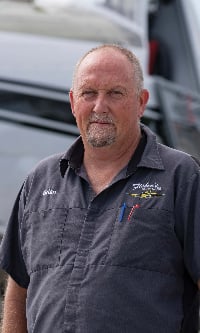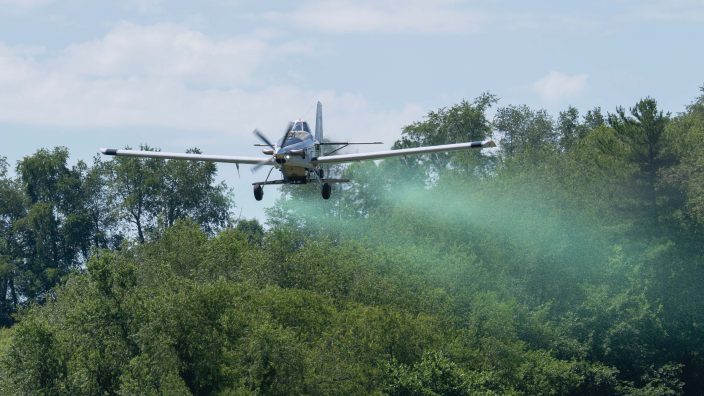Applications for Ohio Farm Bureau Health Plans now available
Members have three ways to apply: contacting a certified agent, calling 833-468-4280 or visiting ohiofarmbureauhealthplans.org.
Read MoreTypically, summer skies over rural Ohio offer quiet, peaceful scenes of sunbeams through puffy, white clouds, bookended by sunrises and sunsets that are so postworthy that pictures overtake social media feeds statewide.
Every once in a while though, the picturesque bright blue backdrop doubles as the canvas for an equally impressive air show from a silver and black aerial applicator, better known as a crop duster.

That one-seat plane is more than likely being expertly piloted by Knox County Farm Bureau member Brian Fisher. His company, Fisher’s Crop Care by Air, applies important nutrients and crop protection products to over 100,000 acres of Ohio corn, soybean and wheat fields each growing season.
Fisher got into his industry much like the way many farmers get into the business: his dad did it. He has been flying for 27 years and has owned the business since 2013. Also just like farming, there is always something to do.
“In the spring, we apply dry fertilizer on wheat and then fungicide closer to harvest,” Fisher said. “Throughout the summer we will get urea on corn fields and spray for pests and apply fungicide in both corn and soybeans, then we transition to flying on cover crops and that will take us all the way through mid-November.”
Although the annual routine may not be much different this year, one major change in how Fisher will be performing his services is the plane itself — a brand new 2020 Air Tractor AT-602, which can reach speeds of almost 200 mph. The efficiency of applying at that rate is one of the many reasons why farmers rely on Fisher to keep their crops thriving throughout the growing season.
“Using the conventional option to apply nutrients, tracks of a ground unit may cause a 3 to 4 bushel per acre decrease in yield due to crop damage,” Fisher said. “Our main business is putting fungicide on corn, and in most cases the corn gets so tall that using a ground rig isn’t a viable option.”
Seasons of higher-than-normal rainfall also will keep Fisher extra busy, as aerial applications can be scheduled in a more timely manner. Soil conditions are a crucial factor in getting equipment into the field.
Fisher is continually amazed with how far technology in his trade has developed since aerial application first took off in Troy, 100 years ago. The new, $1.5 million Air Tractor can hold 630 gallons of liquid fertilizer and 4,000 pounds of dry fertilizer. The plane can spray close to 300 acres per hour and has features that are very new to the aerial application industry.
 “This airplane has an extra electric gate so it can do variable rate or constant rate dry fertilizer applications,” Fisher said. “For liquid, the updated GPS system has flow control to make sure that rates are right where they need to be.”
“This airplane has an extra electric gate so it can do variable rate or constant rate dry fertilizer applications,” Fisher said. “For liquid, the updated GPS system has flow control to make sure that rates are right where they need to be.”
According to the latest Census of Agriculture, Ohio farmers have increased their use of cover crops by 50%. Fisher said he has certainly seen an uptick in the number of acres he plants from the sky, because of the advantages of when he can get the task completed.
“We’ll start in August by putting cover crops into standing corn,” Fisher said. “On the soybean side we will wait until half of the leaves start to turn yellow. That ensures good soil contact with the seed and then the leaves drop to the ground to cover the seeds, keep moisture to them and keep them growing.”
The use of cover crops can have benefits both agronomically and economically. In areas like the Lake Erie watershed, cover crops are being used to help improve water quality and reduce nutrient runoff during months when traditional crops aren’t grown. Cover crops also can mitigate soil compaction, keep residual fertilizer in the field, add organic matter and nutrients to soil and control weeds.
Only about 10% of Fisher’s business is directly with the farmer; the vast majority is done through the co-op system. The local co-ops have knowledge of the soil types, crop conditions and other important variables that help Fisher manage the fields he services with the exact products they need to produce the highest yields possible.
Because of his almost three decades of experience, he is plenty busy flying over developing crops in Ohio, West Virginia, Virginia and North Carolina, but there are few new pilots coming on board to be aerial applicators.
“This is a hard business to get in because of the time it takes to get a commercial pilot’s license, tough regulations and high dollar, faster airplanes,” Fisher said. “The insurance alone is about $80,000 a year and that, alone, is enough to scarea lot of people off.”
Even after thousands of hours in the cockpit and millions of acres covered over his career, Fisher still enjoys his unique role in agriculture.
“The number of people on this planet is growing, so it feels good to know we are doing our part to help farmers keep up with demand for Ohio-grown commodities,” Fisher said. “Just like our customers, we’re simply trying to make agriculture better with everything we do.”
Photos and video by Dave Gore


Members have three ways to apply: contacting a certified agent, calling 833-468-4280 or visiting ohiofarmbureauhealthplans.org.
Read More

Bill Patterson, Cy Prettyman and Adele Flynn will continue to serve as officers for Ohio Farm Bureau Federation.
Read More

Delegates discussed many topics impacting agriculture including farmland preservation, local foods, and succession planning.
Read More

Twenty-six farmers govern the state’s largest farm and food organization.
Read More

The 2025 recipients are Fred Cooke (posthumous) of Richland County, Marvin Dietsch of Williams County, Steven Knollman of Hamilton County and Michele Miller (posthumous) of Ottawa County.
Read More

Nathan and Jill Parriman grow seasonal crops, including Christmas trees, pumpkins and cut flowers, providing U-cut experiences that invite customers to engage directly with agriculture.
Read More

The 2025 Distinguished Service Award recipients are Craig Adams, Mike Townsley, and Kellogg Farms, Kurt Farms and Stateler Family Farms.
Read More

Ohio Farm Bureau Treasurer Adele Flynn participated in the meeting, representing Ohio farmers.
Read More

For Ohio and PJM region, the outlook is reassuring—ample reserves and strong planning should keep the power on.
Read More

The average price for a classic holiday feast for 10 in Ohio will cost $55.87.
Read More